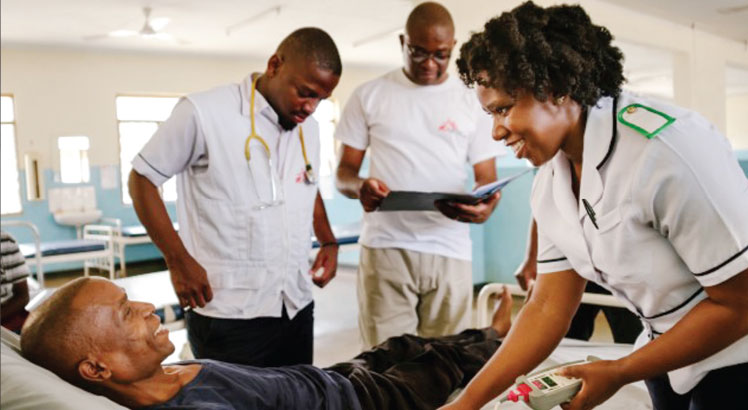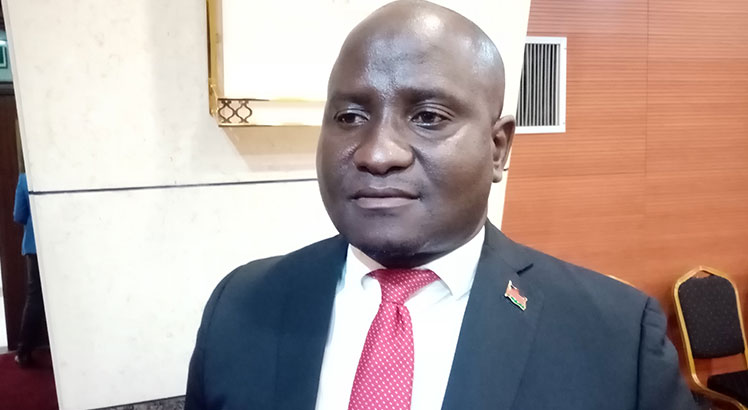Until his death, Jailos Zamayere had worked in South Africa’s gold fields for over three decades.
When he returned home to Balaka District, he was emaciated, frail and coughing blood incessantly.
Catherine Mofolo recalls a widespread rumour that her cousin had been bewitched.
“Jailos sold all the property he brought from South Africa, seeking help from one traditional doctor to another in vain,” she recounts.
The man was diagnosed with tuberculosis at Balaka Rural Hospital, but died a few days afterwards.
The lung disease remains high in Southern Africa’s mining hotspots, where miners inhale toxic dust that fuel TB and silicosis.
A health worker assesses the condition of a patient at Nsanje District Hospital
The East, Central and Southern Africa Health Community (ECSA-HC ) reports that migrant workers are disproportionately prone due to their mobility and weak occupational health and safety regulation.
Regional response
Last month, the inter-governmental regional organisation established in 1974 convened the ninth regional advisory committee meeting of the Southern Africa Tuberculosis and Health Systems Support project in Kigali, Rwanda.
The meeting was held to accelerate national strides towards the Sustainable Development Goals and Heads of State’s commitment to end TB.
This is part of the World Bank-funded project that ECSA-HC jointly implements with the African Union Development Agency (Auda-Nepad).
The AU’s development arm supports the integrated regional response to occupational lung diseases, including TB.
As the project phases out this year, ECSA-HC director general Yoswa Dambisya said there is need for collaborative efforts to harness gains and experience from strategies that work in the push to end TB.
“Essentially, TB anywhere in the region is TB everywhere in the region. The airborne disease knows no borders. Therefore, it is in our best interest to contribute towards its control and elimination,” he said.
His intergovernmental organisation was founded to strengthen cooperation and capacity to address regional health needs.
There were about 2.5 million TB cases in Africa by 2019, according to Dambisya. This represents about 25 percent of the global burden.
“The project targets Malawi, Zambia, Mozambique and Lesotho, which were listed among 30 countries with high TB burden, including multi-drug resistant [MDR] TB and HIV in 2020,” he explained.
TB cases range from 141 in 100 000 people in Malawi to 650 in Lesotho. However, it is highly intertwined with HIV in all countries.
Malawi, Rwanda, Tanzania, Zambia and Mozambique are implementing another World Bank-funded initiative to strengthen national preparedness.
Dambisya said Malawi has greatly improved TB laboratory diagnostic services, a critical area in the regional push to eliminate the ninth leading cause of death and top killer of Aids-related death. Among the gains, the International Organisation for Standardisation (ISO) has accredited the National TB Reference Laboratory in Lilongwe.
Auda-Nepad principal policy specialist Chimwemwe Chamdimba said ending lung disease fuelled by lapses in occupational health and safety is key to the continent’s development agenda.
“Health is one of the continent’s priority areas because we cannot drive the development agenda with a sick human capital,” she explained.
AU has adopted a catalytic framework to end public health challenges, TB, HIV and Aids by 2030.
“One of the main drivers of TB in southern Africa is mining industry,” she stated.
Chamdimba said the AU arm has ramped up the regional response to TB by strengthening laws and policies as well as regional advocacy for strict adherence to occupation health and safety standards.
Edison Rwayasoe, Rwanda’s head of public health surveillance and emergency response, said it is inexcusable for one to die from TB when screening and treatment are freely available in many countries.
He stated: “We need to join hands to combat TB because too many people are pushed into poverty due to lost income, transport costs and other expenses when they have TB.
“Recent surveys show that TB-infected persons’ households spend over 50 percent of their income on TB-related costs. This is well above the marker of 20 percent denoting catastrophic expenditure.”
Faswa Singogo, co-ordinator of the World Bank project in Zambia, said progress to eliminate Aids is slowed by strains that do not respond to isoniazid and rifampin, the most powerful antibiotics used to treat the disease.
Lesotho National Tuberculosis and Leprosy Programme manager Llang Maama said while TB can remain dormant in the body and latently infected individuals do not display any symptoms, infection becomes active and deadly once the immune system drops.
“A third of the world’s population has latent TB, so regional integration in strengthening health security interventions is critical,” she said.
Sustainability gap
James Mpunga, head of Malawi’s National TB and Leprosy Programme, said the country’s disease surveillance and response has positive feedback from the World Bank team despite disruption caused by the Covid-19 pandemic.
He said: “Despite the gains, Malawi needs to work on sustainability because domestic resource envelope is shrinking as we rely heavily on donors.
“We need to sustain the gains using local resources and perhaps new partners.”
World Bank task team leader Humberto Khoza said the regional bodies should build on the positive trajectory by improving on primary prevention, treatment and management of lung diseases.
The post ‘TB anywhere is a threat everywhere’ appeared first on The Nation Online.
 Moni Malawi
Moni Malawi 

